Frame by Frame Comparison of
a DC9 and a Flying Triangle
by Bruce Cornet, Ph.D.
Table of Contents
On 25 January 1997 Bruce Cornet and John Macedo, Jr. witnessed three craft as they flew low over them, traveling east at an altitude of about 1,000 feet, and disappeared on the east side of the Wallkill River Valley, New York State. For a comprehensive description of what happened that night, see The Landings. This web page addresses only the identity of the first AOP that flew over them at 8:17 pm. There has been much confusion and debate on the identity of the first AOP due to its navigation lights and reflections, which are similar to that of a DC9. American Airlines DC9's are a frequent sight at Stewart International Airport 9 miles away to the southeast of their location, and numerous DC9's have been witnessed during the previous five years crossing the area where Cornet and Macedo stood as they flew towards Stewart.
What Cornet and Macedo witnessed was not an airframe silhouette with which they were familiar. Even when the AOP was directly over Cornet, he could not detect any forward projecting fuselage or tail assembly. All he saw was what appeared to be a flying wing or flying triangle (FT) with one or two booms sticking out front and a long antenna-like projection off the back, which waved from side to side in the wind. Cornet had already witnessed back on 23 June 1992, and again on 24 September 1992, a black cylindrical fuselage unfold wings and stabilizers to become - resemble a Boeing 707. However, it had no engine pods on its wings or fuselage, and it had no apparent windows on the fuselage - not even cockpit windows. See Special Agent 707.
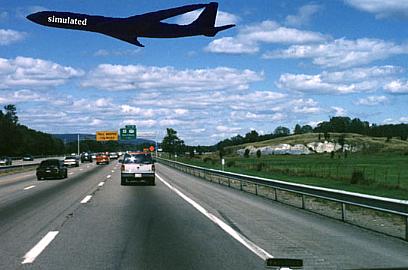
On other occasions he had seen flying triangles in the valley that mimicked the navigation lights and sounds of conventional aircraft. See Mimicry may be the Objective of ETI Triangular and Diamond-shape Probes. Frequently upon close examination and analysis of the data collected, significant anomalies arose that confirmed what his eyes saw (or didn't see). For the skeptic, however, anecdotal data is insufficient, because observers can be mistaken; they can see things that are filtered/modified by the observers brain and made to conform with expectations, and they can be deceived by sounds and unexpected tricks of lighting - especially at night.
For additional video data on this type of Flying Triangle, see
FT over Richmond, Virginia (8 August 2002).
http://www.sunstar-solutions.com/AOP/LynchVA/FT-VA.htm
Materials and Methods
Location: South Searsville Rd.
Date: 25 January 1997.
Time: 8:17 pm.
Aircraft: Unknown (AOP).
Location: Red Mills Rd.
Date: 13 September 1997.
Time: 9:14 pm.
Aircraft: DC9 on approach to Stewart International Airport.
Camcorder: Sony Hi8 Handycam CCD-TRV81.
Software programs: Adobe Photoshop LE (graphics); Grabit (video frame capture);
ThumbsPlus 3.20-S (resizing); FrontPage 98.
Data Comparison
The graphics and images presented below compare captured frames from two videos. In both cases the path of the aircraft was similar, and the position of the cameraperson was similar relative to the flight paths. Consequently, relatively similar images can be compared and analyzed.
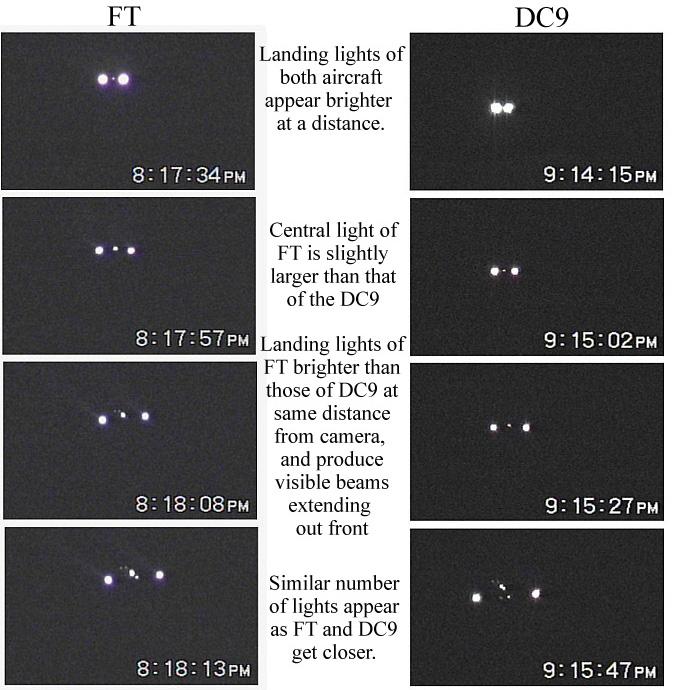
Mimicry or Identity?
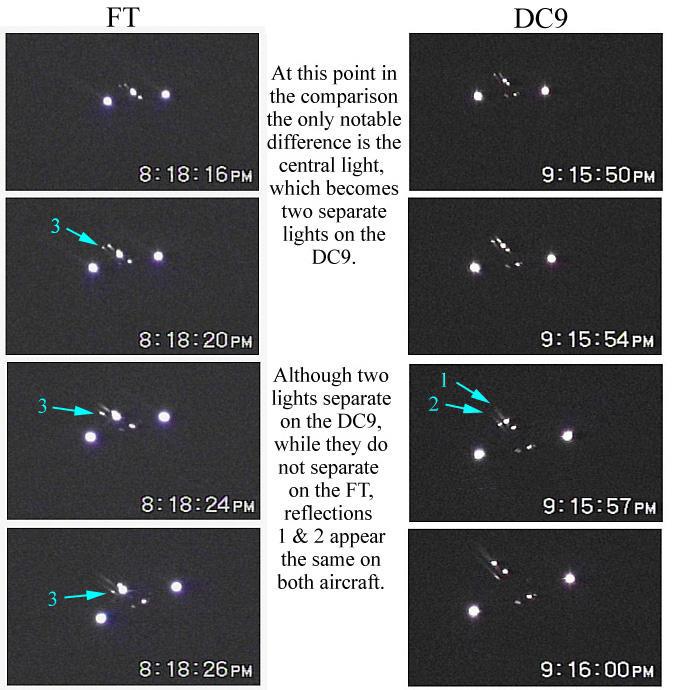
Light #2 (DC9) and light #3 (FT) are analogous, but that light on the FT is given a different number for reference below.
There are two distinct lights on each side of the forward fuselage (in front of wing) of a DC9. The forward light of the two is lower on the fuselage than the rear light. Both lights on the near side are visible, while one or the other (but not both) of the two lights (#2) on the far side of the fuselage is visible. Note how the far side lights change in position in images for DC9 times 9:15:57 and 9:16:00 (above right), indicating that orientation plays a key role in which lights are visible (not blocked by fuselage). On the images of the FT, the far side light (#3) shifts in a similar manner, but the near-side foreward light actually disappears (even though its reflection does not).
A DC9 lands at Stewart International Airport (Newburgh, NY) below.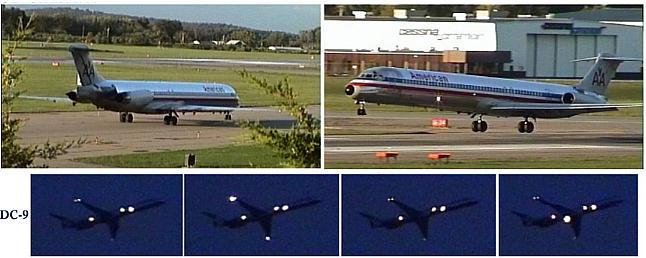
There are also lights/reflections on the forward cowlings of each rear engine. There are wingtip strobes and a central belly strobe.
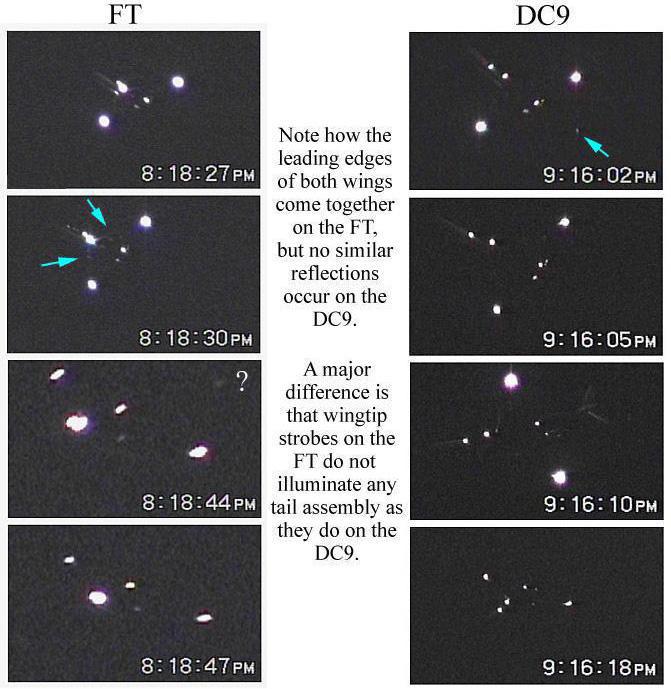
But when both aircraft flew overhead, distinct differences emerged. An overlay with resizing and rotation reveals the similarities and differences:
The central middle lights on the FT (white, #1 and #2 in white) do not separate; a smaller light can be seen clearly just above a larger lower light. There are two separate lights on the DC9 (yellow, #1 and #2 in blue). See Lynch's video images of an identical FT. His digital images are much clearer than Cornet's analog images.
http://www.sunstar-solutions.com/AOP/LynchVA/FT-VA.htmThere are three small lights in a row in front of the central paired lights on the FT (x, y, z arrows below). These lights have been confused with window reflections by skeptics, but no similar reflections occur on the DC9 images.
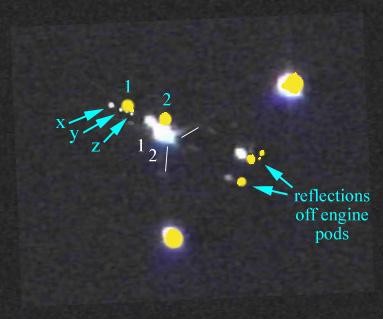
In addition, booms were seen sticking out front of the FT, and small lights could have been attached to them in order to create illusions seen on the video of the FT. In another video lights on a boom in front of an FT can be clearly distinguished as they rotated in different directions. The forward fuselage lights on a DC9 are fixed, and cannot rotate.
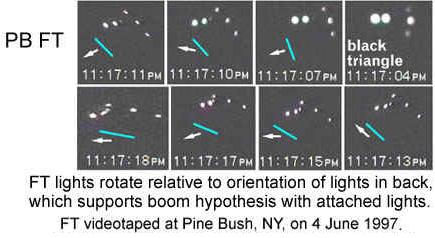
The "wingtip" lights on the FT (white) are larger and/or brighter than the analogous lights on the DC9 (yellow). This can be explained in part by resizing of the image for the overlay (FT image had to be enlarged), but that also means the FT was smaller than the DC9 (see below).
The lights in front of the two tail-mounted engines on the DC9 (yellow, reflections) are positioned further towards the rear (where the engines are located). The mismatch of analogous lights for the FT is consistent with it not having a tail section, requiring that mimic lights (white) be attached on the deltoid-shaped fuselage. In addition, the two rear central lights on the FT are not equal in size/brightness, as they are for the DC9 (except where partially blocked/obscured by the fuselage). This is most evident when both aircraft are viewed from the rear. The smaller light on the FT actually disappears, while both lights are still visible on the DC9, even though one is partially obscured (less bright).
Faint reflections off the leading edge of the FT deltoid-shaped wing (indicated by two paralleling lines) can be seen to extent to the central paired lights, indicating that there is no room for a conventional aircraft fuselage extending forward of the wings.
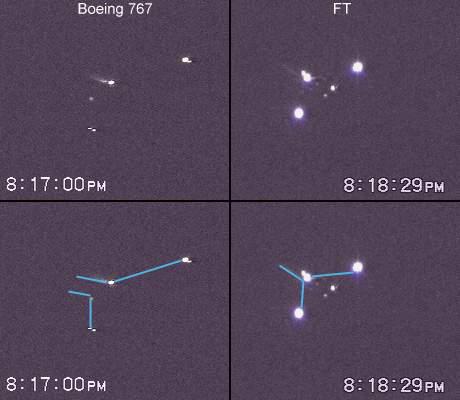
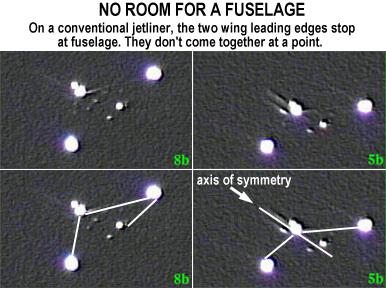
The two smaller lights that initially appeared to the left of the larger paired central lights on the FT have reflections in front of them, like the two lights on the DC9. Unexplainable is how the light that is producing the reflection on the near side disappears in subsequent frames (see sequence below), even though its reflection does not disappear. This is not the case for the DC9, where a light is always associated with each reflection.

The smaller far side light (#3 arrows above) actually slides towards the rear on the FT, indicating that it is not comprised of two separate lights as on the DC9. As orientation changes on the DC9 the forward light is visible, then the rear light (#2 arrow above). Because the two lights on the forward fuselage of the DC9 are not in line with one another, they cannot merge with one another. Each light on the far side is paired (opposite) with a light on the near side on the DC9. This is not the case for the FT.
The sizes of the aircraft are different. Even though the exact altitudes are not known, the DC9 was descending from the overhead cloud ceiling on a glide path to the runway. It appeared to be descending below 1,500 feet in altitude when it passed over the observers. The FT (AOP #1), on the other hand, was not much higher than 1,000 feet when it began its approach.
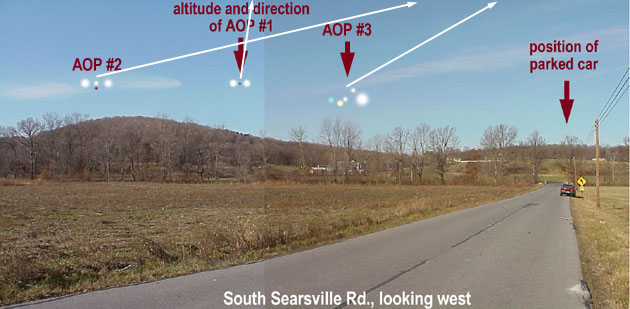
In the videos the FT appears significantly smaller than the DC9 (see below). A DC9 wingspan is slightly more than 107 feet, implying that the FT wingspan might be in the range of that of a smaller private jet (e.g. 45 feet).

But perhaps the most telling data comes from what strobes illuminate on an aircraft. When the DC9 wingtip strobes flashed, they were bright enough to illuminate the distictive T-tail of a DC9, along with some of the forward fuselage. When the strobes on the FT fired, no additional fuselage or tail section was illuminated.
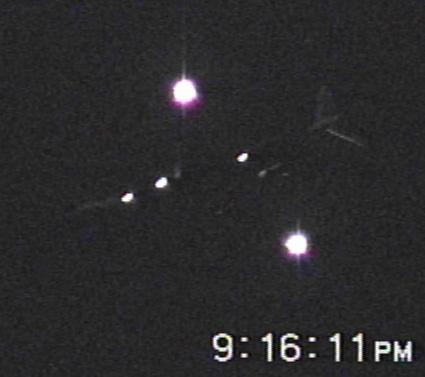
If the FT were a smaller private jet, perhaps its tail might remain less visible. Images of a Sabreliner taking off from Stewart airport (videotaped with the same camcorder, February 1997) reveal a similar picture to that of the DC9.
Wingtip strobes reflect off of the tail section and engine pods.
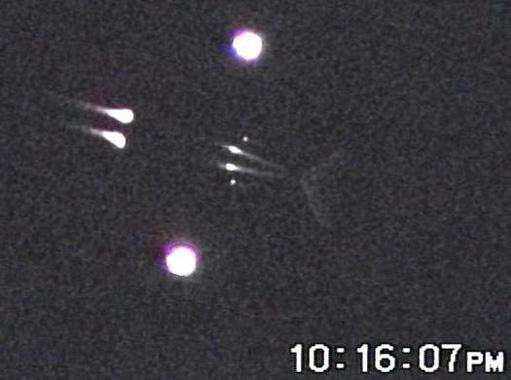
Red belly strobe bright enough to reveal tail section.

There is no clear-cut evidence that the 25 January 1997 FT had a normal tail assembly, although the video did capture something moving back and forth (flexible) behind the craft just as it passed over the observers. As it moved, it reflected light coming from the FT's lights, and briefly became visible. How about a flexible antenna or decoy?
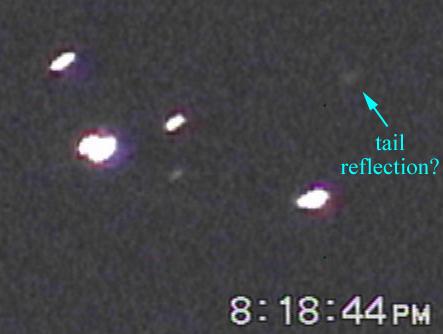
The sound made by the FT was not typical for a conventional jetliner. No sound was picked up by the camcorder until the FT was almost directly over the observers (at 8 second mark on frequency spectrogram below). This is usually not the case for conventional jetliners, which often can be heard approaching from at least a quarter mile away. In addition, there is significantly less white noise (blue above 2 kHz) evident in the frequency spectrogram for the FT than for that of most jetliners.
Spectrogram of FT recorded on 25 January 1997.
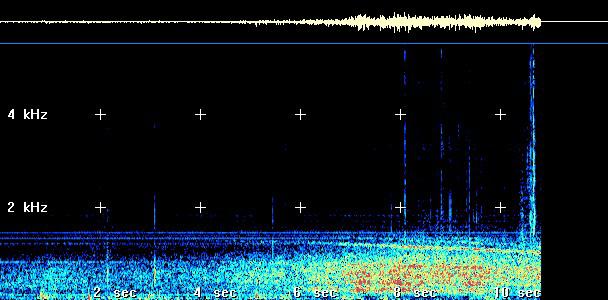
Spectrogram of jetliner (DC9) recorded on 27 June 1997.
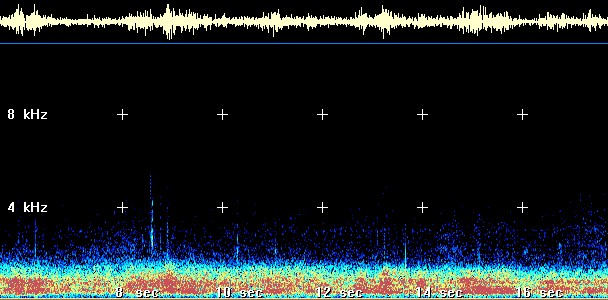
The sound produced by the jetliner rumbles and breaks up into louder and softer segments, while that of the FT is brief and punctuated by distinct frequency bands.
Why spend this much time and effort analyzing data from one recorded event? Because the truth is in the details. A less exhaustive analysis is presented on my web page called The Landings, where Cornet describes all three craft which flew over John Macedo, Jr. and him on 25 January 1997 before disappearing from sight to the east. The first AOP (#1) was a Flying Triangle (FT). The second one (#2) looked like a DC9, but without any engines on its wings or fuselage. The third one (#3) was the diamond-shape Manta Ray, which put on a show of colored lights in positions and hues not found on conventional aircraft. All three AOP reappeared before them at another location in the valley later that same evening. All three reappeared in succession, one after another, as they turned on their lights. Each one slowly circled back to the south, brightened its landing lights, and slowly descended over an area where no airport landing strip exists. All three craft could be seen descending below tree top level near or over Lake Osiris.
By itself that triple performance stands out as anomalous, but highlights the nature of such sightings and events recorded by Cornet in the Wallkill River Valley between June 1992 and May 2000. Each of the three craft observed on the night of 25 January utilized arrangements of navigation and landing lights that mimicked patterns of conventional jetliners, but with critical differences revealed on Cornet's numerous web pages.
For example, lamps are used on all conventional and military aircraft designed and built by humans. The behavior of the brightest lights on anomalous craft indicates that they are not lamps, but are sources of ionization called plasmas. The picture below shows a time exposure of two bright plasma streams, one of which can be seen breaking up into balls or spheres characteristic of plasma energy.
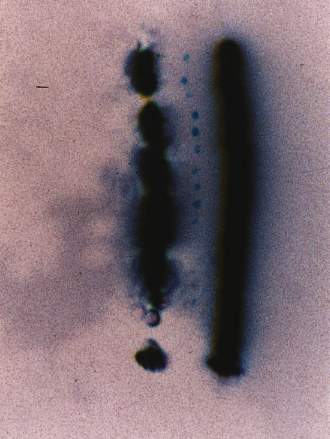
When those lights brighten beyond a certain candle power they ignited the air around them to produce plumes of orange-red gas (seen in the negative above as darker emanations coming off the left and right sides of the plasma streams). Analysis of images of those lights and gas showed that they were not the product of chemical burn, as is typical of nighttime flares, but were the product of high temperature ionization with the production of brown nitrous oxides (combined N and O in atmosphere), which glow orange-red when hot and electrically stimulated.
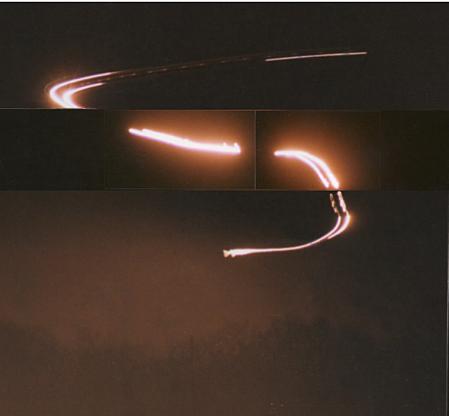
Cornet has documented anomalous craft that resembled or could easily be mistaken for conventional jetliners, and which copy/mimic the navigation and landing lights of conventional aircraft.
A triangular-shaped craft with extra stuff sticking out front and back. This type of craft can stop and hover. See Volume III at the BUFOD website for another exhaustive study of videos and time exposures for a performance by two FTs on 17 May 1997. One FT approached the cameras almost silently, turned, rolled over onto its back (time exposure proves it was not a bank and turn) while rapidly firing its strobes,
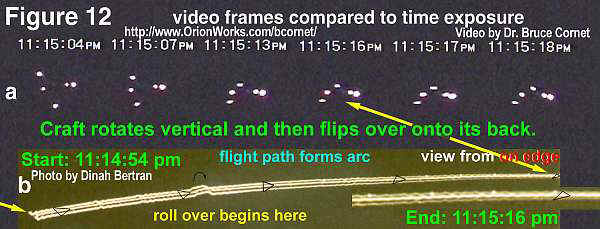
then rotated 180 degrees so that it was flying upside down and backwards, then flipped over forward as it rapidly slowed while descending (an aviation impossibility using conventional aircraft - pilot comment),
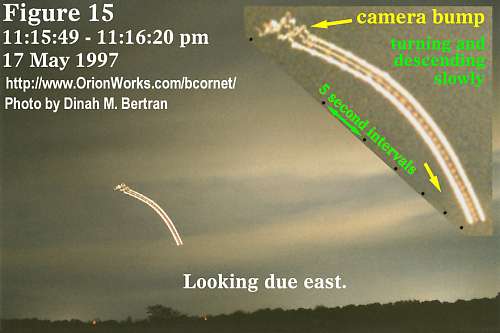
and eventually disappeared below tree tops in a field about two miles away.
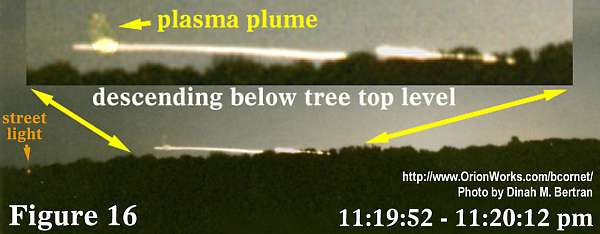
A Boeing 707-shaped craft without external engines, colored solid black, without any windows or identification markings. This type of craft can stop and hover. Its body can autoilluminate.
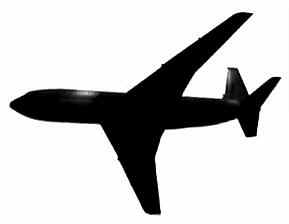
A DC9-shaped craft with T-tail and without external engines, colored solid off-white, without any identification markings. This type of craft can stop and hover. Its body can autoilluminate.
A diamond-shape craft without external engines, colored solid black, without any identification markings. This type of craft can stop and hover. It can produce multicolored lights in various positions on its belly, including a central double row of bright white lights.
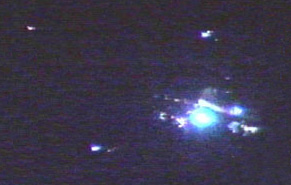

Why is it difficult for most people to think that one strategy extraterrestrial intelligence (ETI) would use for its probes in the study of Earth is mimicry? The animal world utilizes mimicry to perfection in protecting prey from predators, or allowing predators to blend in with their background.
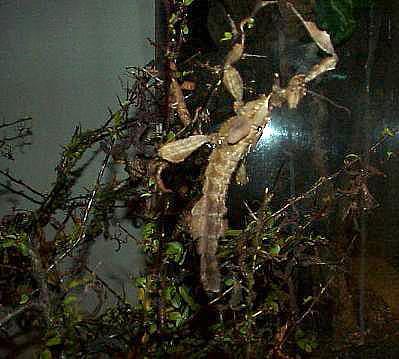
What better way to gain intelligence about our planet, especially human civilization, than to blend in with our aircraft through the use of natural disguises (e.g. cover of darkness), illusions (e.g. familiar sounds and false projections), and mimicry (e.g. if it looks like a duck)? Based on the comments I have gotten back from skeptics and UFO enthusiasts, we humans see only what we want to see. We explain away that which does not fit our world view paradigm and collective concept of reality. The narrow bandwith of SETI member thinking is a case in point. Rather than test all hypotheses, SETI dogma strongly discourages its members from investigating anything that might indicate that ETI probes are already here on Earth. Ridicule and censorship are used with stunning effectiveness.
To my way of thinking the best "Rorschach test" intelligent ET probes could give to humans would be one involving shapes and patterns in the night sky. Mimicry coupled with intentional anomalies might have been used as a means for ETI to judge human perception (senses), to judge deductive and inductive reasoning (puzzle solving), to determine reality filters (e.g. beliefs), to ascertain emotional filters (e.g. fear), and to ultimately discover - - - the range of human intelligence quotient (IQ). But scientists know that more than one test has to be conducted and many humans used for the results to be valid. Question is, have other witnesses to AOP been utilized for the same purpose? And how many of them were trained scientists?
In many ways the performances of these craft fit George Hansen's concept of the "trickster," who operates at the fringes of normalcy and who frequently crosses physical and psychological boundaries. "The Trickster and the Paranormal explains why controversies over psychic phenomena continue and why they show no signs of abating." The use of "trickster" methods by ETI is a form of defense shield against being caught and verified. It has certainly worked that way by keeping most scientists from taking a serious look at phenomena which are considered paranormal.
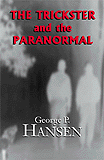 |
"UFOs are physically real. But they
are embedded in a matrix of deception and irrationality. This book explains how and
why. Cases are presented along with theories from anthropology." "Deception and trickery have accompanied psychic phenomena for millennia. Proponents are oblivious to this fact. Skeptics point it out, and make an important contribution in doing so." |
Perhaps I was used as a control in an ETI experiment. For example, was I used to determine the effectiveness of ETI camouflage? It is unlikely that my involvement and participation was an accident. Was I specifically selected for my background, education, and willingness to go against the scientific grain when data pointed in a controversial direction? I know of few other people, and no other scientists, who have been given 130 sightings and performances by unconventional technology. That amount of effort on the part of ETI could not have been just for my entertainment or just for contact purposes. Could any human organization afford the tens of millions of dollars required to conduct comparable performances and experiments using conventional technology? And to what end? The many dozens of web pages containing the data I collected between June 1992 and January 2000 attest to the benefit to science (if utilized by other scientists) that came out of my participation in a probable ETI experiment. ET must have gotten something very important to them in return that would justify such an expenditure. So, what was it?
Bruce Cornet, Ph.D.
Geologist, Paleobotanist, Palynologist
bcornet@direcway.com
27 Tower Hill Ave.
Red Bank, NJ 07701
Web page created on 19 December 2001
Last updated on
05/03/2023